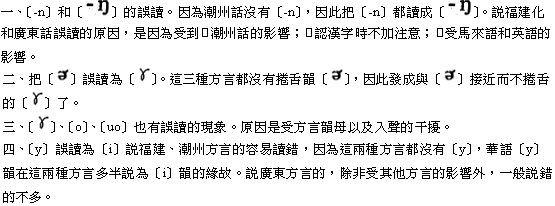新加坡華文教師華語語音分析
作者:張孝裕、李尚志、李以星(國立臺灣師範大學文學院國文系)
摘要:
新加坡的華人所操的方言很複雜,其中以福建、潮州、廣東、海南、客家(Hakka)各種方言居多。近年來新加坡政府積極推廣華語,發現華人的華語發音,受 到方言的干擾與影響很大,因此,新加坡教育部迫切想提高華文教師的華語水準,於是著手分析研究不同方言背景的教師,他們華語受方言影響的實況,供作改進的 參考。
一九八○年十月起教育部與教育學院(Institute of Education)合辦了"華文教師華語語音進修班",我得到劉尚志先生(Mr. Low Siang Chee)和李以星女士(Mdm. Lee Yee Sing)的合作,把"華文教師華語語音進修班"第一屆七十九位學員作為調查和分析的對象。他們都是小學和啟蒙班的華文教師,其中說福建話(閩南話)二十 九人,潮州話二十人,廣東話(廣州話)十八人,海南話六人,客家話二人,因為說海南話和客家話的人數太少了,無代表性,因此,只選說福建、潮州和廣東三種 方言的七十一位了。
我們首先以說這三種方言的人講華語時,容易犯上聲、韻、調錯誤的,編了些語詞,在這七十一位教師接受語音訓練之前,請他們錄音,希望盡量保存他們原有的語 音。當我們聽錄音發現他們發音有錯誤時,就按聲、韻、調分別記錄在特別設計的語音分析表中,然後才作分析、歸納和統計等工作。我們必須根據發音的原理,這 三種方言與華語的對應關係,古今音演變的現象以及中國字構造的道理,來作判斷他們發音錯誤的原因,最後才作出結論大致是:
在聲母方面:

四、〔p〕和〔p'〕,〔t〕和〔t'〕,〔k〕和〔k'〕也有錯誤。這是受漢字構造或方言類推的緣故。
五、〔n〕和〔l〕,〔x〕和〔f〕的誤讀都是受到方言與華語不一致的影響。
在韻母方面:

在聲調方面:
一、 把該讀全上的說成半上,這種情形很普遍。
二、 因為三種方言都有入聲,說華語受了干擾,因此,原屬於入聲字的,說華語也像入聲般短促,或像去聲。
三、 屬於聲調不同的岐音異義字,因誤讀而成為調的錯誤。
 《詳全文》
《詳全文》
Journal directory listing - Volume 21-30 (1976-1985) - Volume 27 (1982)
An Analysis of the Pronunciation of Teachers of the Chinese Language in Singapore
Author: Hsiao Yu Chang, Low Siang Chee, Lee Yee Sing(Department of Chinese College of Liberal Arts)
Abstract:
The "dialects spoken by Chinese in Singapore are varied and complicated Among them are Fukien, Chiaochow, Cantonese, Hannai and Hakka dialects. In recent years, the government of Singapore has launched a campaign of Chinese language teaching. The pronunciation of the Singaporean Chinese is found to have suffered from the interference of different dialects. Therefore, the Ministry of Education of Singapore felt that a program to upgrade the quality of Chinese language teachers was urgently needed. To attain this goal, the first step was to undertake an analysis as to how far the Chinese teachers were influenced by their dialectical background. The result of this analytical survey would be used as a reference for the improvement of Chinese language teaching.
In October 1980, Singapore's Ministry of Education and Institute of Educa-tion jointly put forth an advanced program of Chinese Phonetics for Chinese language teachers. In cooperation with Mr. Low Siang Chee and Mdm. Lee Yee Sing, I undertook a survey in which 79 students of the first group of the Chinese Phonetics for Chinese Language Teachers (CPCLT) program answered our question-naires. The 79 persons were themselves teachers of Chinese language of primary schools and pre-school classes. Among them 29 spoke Fukienese, 20 spoke Chiaochow dialect, 18 Cantonese, 6 Hainal dialect, 2 Hakka dialect. Those who spoke Hainan and Hakka dialects were less than representative, and therefore not considered for the survey. The number of students surveyed was reduced to 71. They represented speakers of Fukienese, Chiaochow dialect, and Cantonese.
Our survey began with the recording of the 71 teachers, who spoke dialects, before they received formal training of the program, in order to preserve the language (dialect) they used to speak. From the recording we found out some words and phrases whose initial consonants, final vowels and tones were easily mis-pronounced. To examine and analyze the mistakes made by them, we listened to the recording and took note of the mistakes on a specially designed sheet according to their initial consonants, final vowels and tone. Based on the theory of pronuncia-tion, we tried to figure out (1) their corresponding homologues, (2) the change of sound in ancient and modern times, and (3) the structure of Chinese characters. These three elements served as the basis for checking out the causes of mistaken pronunciation.
The findings of this survey are categorized into three groups: those of initial consonants, of final vowels, and of tone. Recommendations and suggestions are given for reference in the concluding chapter.